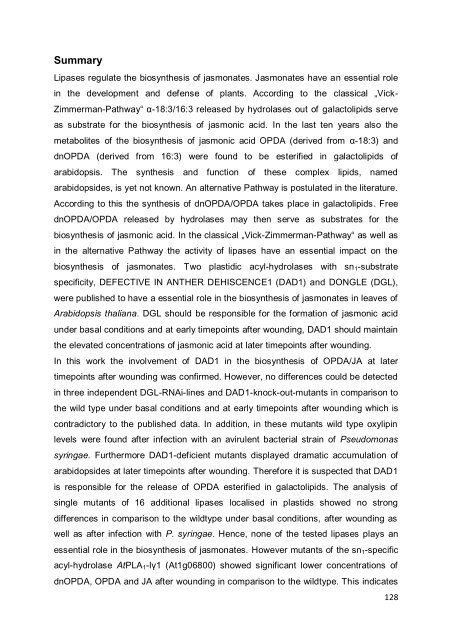Arabidopsis thaliana - OPUS - Universität Würzburg
Arabidopsis thaliana - OPUS - Universität Würzburg
Arabidopsis thaliana - OPUS - Universität Würzburg
Erfolgreiche ePaper selbst erstellen
Machen Sie aus Ihren PDF Publikationen ein blätterbares Flipbook mit unserer einzigartigen Google optimierten e-Paper Software.
Summary<br />
Lipases regulate the biosynthesis of jasmonates. Jasmonates have an essential role<br />
in the development and defense of plants. According to the classical „Vick-<br />
Zimmerman-Pathway“ α-18:3/16:3 released by hydrolases out of galactolipids serve<br />
as substrate for the biosynthesis of jasmonic acid. In the last ten years also the<br />
metabolites of the biosynthesis of jasmonic acid OPDA (derived from α-18:3) and<br />
dnOPDA (derived from 16:3) were found to be esterified in galactolipids of<br />
arabidopsis. The synthesis and function of these complex lipids, named<br />
arabidopsides, is yet not known. An alternative Pathway is postulated in the literature.<br />
According to this the synthesis of dnOPDA/OPDA takes place in galactolipids. Free<br />
dnOPDA/OPDA released by hydrolases may then serve as substrates for the<br />
biosynthesis of jasmonic acid. In the classical „Vick-Zimmerman-Pathway“ as well as<br />
in the alternative Pathway the activity of lipases have an essential impact on the<br />
biosynthesis of jasmonates. Two plastidic acyl-hydrolases with sn1-substrate<br />
specificity, DEFECTIVE IN ANTHER DEHISCENCE1 (DAD1) and DONGLE (DGL),<br />
were published to have a essential role in the biosynthesis of jasmonates in leaves of<br />
<strong>Arabidopsis</strong> <strong>thaliana</strong>. DGL should be responsible for the formation of jasmonic acid<br />
under basal conditions and at early timepoints after wounding, DAD1 should maintain<br />
the elevated concentrations of jasmonic acid at later timepoints after wounding.<br />
In this work the involvement of DAD1 in the biosynthesis of OPDA/JA at later<br />
timepoints after wounding was confirmed. However, no differences could be detected<br />
in three independent DGL-RNAi-lines and DAD1-knock-out-mutants in comparison to<br />
the wild type under basal conditions and at early timepoints after wounding which is<br />
contradictory to the published data. In addition, in these mutants wild type oxylipin<br />
levels were found after infection with an avirulent bacterial strain of Pseudomonas<br />
syringae. Furthermore DAD1-deficient mutants displayed dramatic accumulation of<br />
arabidopsides at later timepoints after wounding. Therefore it is suspected that DAD1<br />
is responsible for the release of OPDA esterified in galactolipids. The analysis of<br />
single mutants of 16 additional lipases localised in plastids showed no strong<br />
differences in comparison to the wildtype under basal conditions, after wounding as<br />
well as after infection with P. syringae. Hence, none of the tested lipases plays an<br />
essential role in the biosynthesis of jasmonates. However mutants of the sn1-specific<br />
acyl-hydrolase AtPLA1-Iγ1 (At1g06800) showed significant lower concentrations of<br />
dnOPDA, OPDA and JA after wounding in comparison to the wildtype. This indicates<br />
128

















